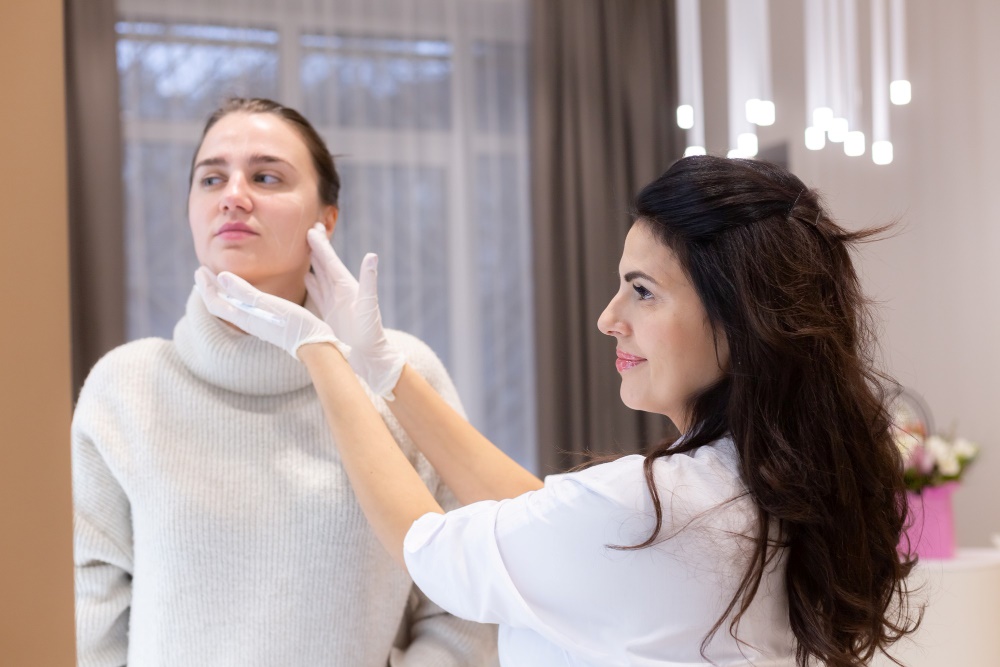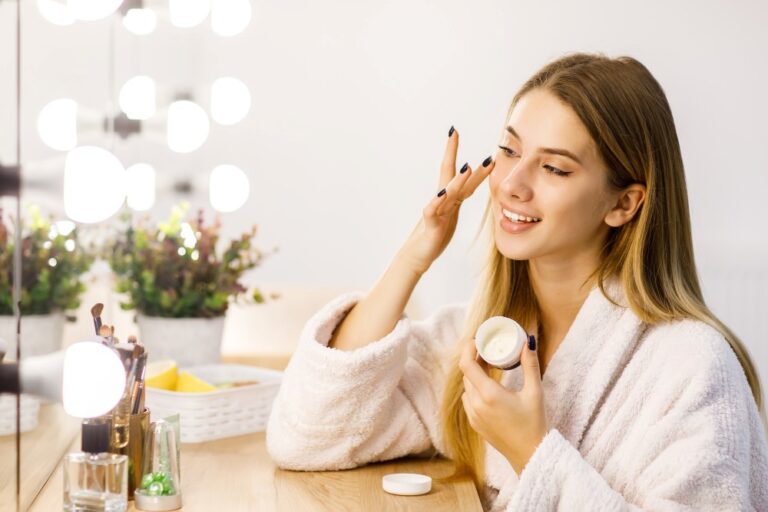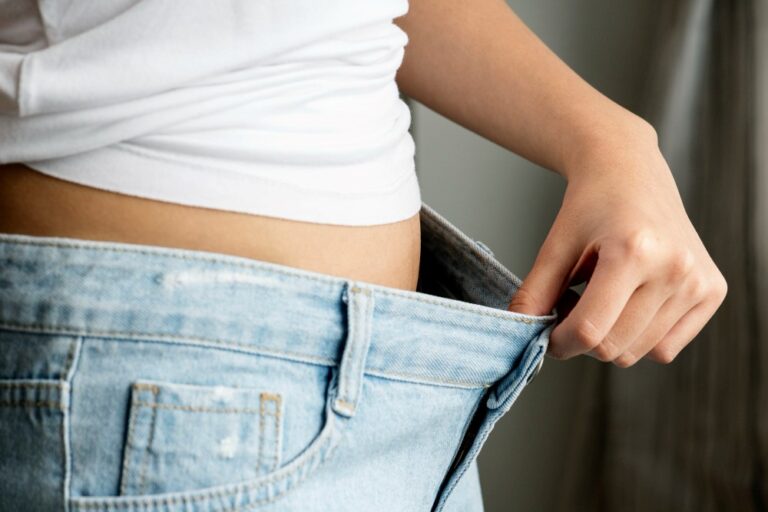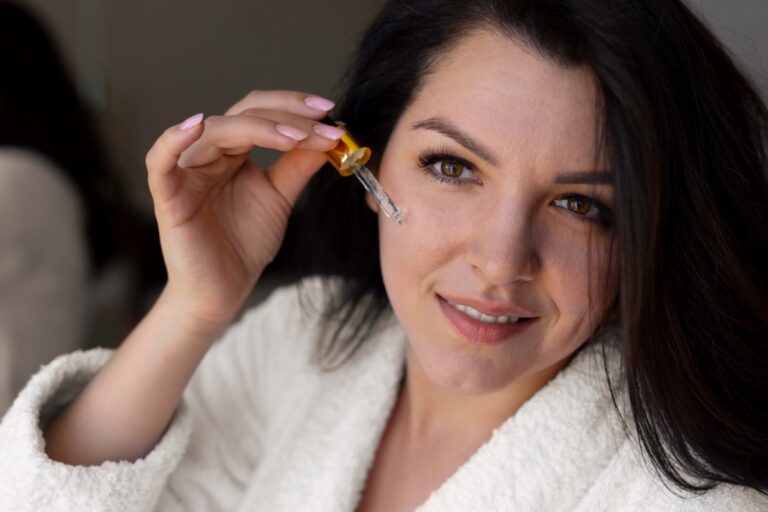Getting Botox, fillers, or microneedling is a big step toward feeling more confident in your skin. But the truth is—what you do after the treatment matters just as much as the procedure itself. A little care goes a long way.
These treatments work beneath the surface, and your skin needs time to heal and settle. Skip the right steps, and you risk swelling, irritation, or even messing up your results. Follow them, and you’ll see smoother, more natural improvements that last.
In this guide, we’ll walk you through what to do (and what to skip) after your appointment. Whether you’re new to aesthetics or just need a quick refresher, this will help you heal faster, look better, and feel more at ease in the days ahead. So let’s get into the details, starting with the basics that apply to every treatment.
Table of Contents
General Guidelines for Post-Treatment Care
Whether you had Botox, fillers, or microneedling, some recovery rules apply across the board. These simple steps help your skin heal properly and improve your overall results.
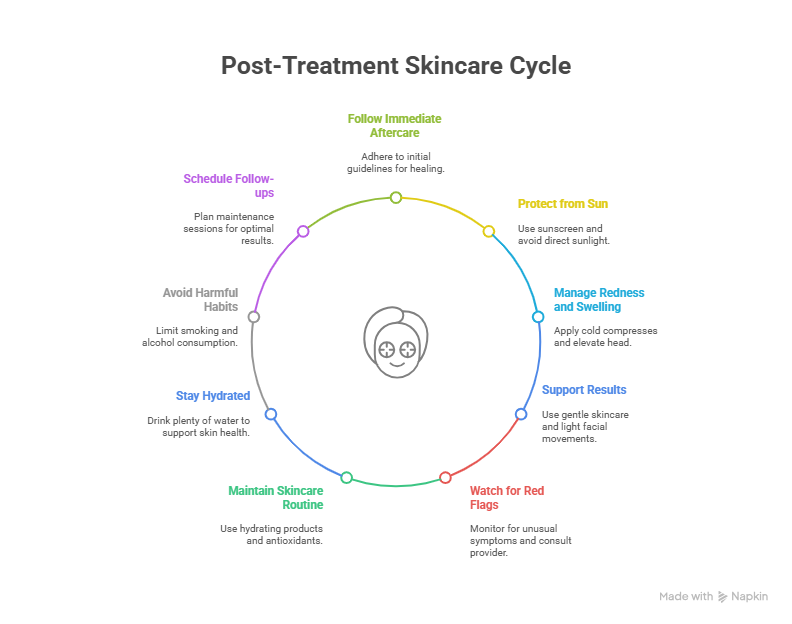
Immediate Aftercare Rules for All Procedures
- Hands off: Don’t touch, rub, or press on treated areas for at least 24 hours.
- Skip makeup: Avoid foundation, concealer, or any skincare with fragrance or active ingredients for the first day.
- No workouts or heat: Hold off on exercise, saunas, steam rooms, or hot showers for 24–48 hours.
- Avoid alcohol: Alcohol can increase swelling or bruising, especially after fillers.
- Use cold compress (if approved): Apply gently to reduce swelling, but always check with your provider first.
Sun Protection Is a Must
- Always wear sunscreen: Use a mineral SPF 30 or higher—even on cloudy days.
- Stay out of direct sun: Especially for the first 72 hours.
- Cover up when outside: A wide-brimmed hat and shade can protect sensitive skin.
Managing Redness, Swelling, or Discomfort
- Mild swelling and redness are normal: It usually fades within a few days.
- Sleep with your head elevated: This helps reduce puffiness overnight.
- Watch for anything unusual: Call your provider if you notice signs of infection—like pus, growing redness, or increasing pain.
Botox Recovery Tips
Botox works by relaxing specific muscles to smooth out fine lines and wrinkles. The procedure is quick, but your aftercare still matters if you want smooth, natural results.
What to Expect After Botox
- Mild swelling or redness: This may show up around the injection sites and should fade within a few hours.
- Slight tightness or heaviness: You might feel your forehead or brows react differently at first—that’s normal.
- Delayed results: Botox doesn’t work instantly. Most people start seeing changes in 3–5 days, with full results around 7–10 days.
What to Avoid After Botox
- Don’t lie down flat for at least 4 hours: This helps prevent the Botox from moving to unintended areas.
- No rubbing or massaging the area: Especially in the first 24 hours. Let the product settle undisturbed.
- Skip other face treatments: Hold off on facials, chemical peels, or massages for 7 days.
- Avoid heavy exercise or heat exposure: That includes saunas, hot yoga, and long hot showers for the first 24 hours.
How to Support the Results
- Keep your head elevated during rest: Especially the first night.
- Use clean, gentle skincare: Avoid actives like retinol or exfoliants for 24 hours.
- Light facial movement can help: Smiling, frowning, and raising your brows gently may help the Botox settle (if your provider recommends it).
- Book touch-ups if needed: If after two weeks your results feel uneven, a small adjustment may help.
Dermal Fillers Recovery Tips
Dermal fillers add volume, shape, and smoothness to areas like the lips, cheeks, and under-eyes. While the results are often immediate, the treated areas need time to settle and heal.
What to Expect After Fillers
- Swelling and mild bruising: This is very common, especially around the lips or under the eyes. It can last a few days up to a week.
- Tenderness or small lumps: You may feel firm spots right after treatment—these usually soften on their own.
- Full results take time: The final look often appears after 7–14 days once swelling goes down.
What to Avoid After Filler Injections
- No touching or pressing on the area: This can shift the filler or cause more swelling.
- Skip alcohol and blood thinners: Things like aspirin, ibuprofen, or wine can increase bruising. Avoid them for at least 24–48 hours unless prescribed.
- Hold off on workouts or heat: No intense exercise, hot baths, or saunas for 48 hours.
- Avoid facial treatments: Wait at least 2 weeks before getting facials, lasers, or microneedling on the same area.
How to Care for Your Skin After Fillers
- Apply cold compresses gently: Use a clean cloth with ice packs for short periods (if your provider approves it).
- Use Arnica or Bromelain (if recommended): These can help reduce bruising.
- Stay hydrated: Drink plenty of water—fillers bind to water and hydration helps them settle well.
- Sleep on your back: Avoid pressing your face into the pillow while you sleep for the first few nights.
Microneedling Recovery Tips
Microneedling works by creating tiny, controlled injuries in the skin to boost collagen and improve tone, texture, and scars. It’s effective—but recovery takes a bit more patience than injectables.
What to Expect After Microneedling
- Redness and sensitivity: Right after treatment, your face may look and feel like a mild sunburn.
- Tightness or dryness: Skin might feel tight or dry for a few days.
- Light peeling or flaking: This can happen around day 3–5 as your skin renews itself.
- Best results appear over time: Skin continues to improve over several weeks as collagen builds.
What to Avoid After Microneedling
- No makeup for 24–48 hours: Let your skin breathe and heal.
- Skip active skincare products: Avoid anything with retinol, glycolic acid, salicylic acid, or vitamin C for about 5–7 days.
- No sweating or heat exposure: Avoid workouts, saunas, and hot showers for the first 24–48 hours.
- No exfoliation: Don’t scrub or pick at flaking skin—let it shed naturally.
- Limit sun exposure: UV rays can cause irritation or dark spots on freshly treated skin.
How to Support Healing
- Use a gentle cleanser and moisturizer: Stick to fragrance-free products that soothe and hydrate.
- Apply hyaluronic acid serum (if recommended): It helps lock in moisture and supports healing.
- Keep skin protected: Wear sunscreen daily starting 24 hours after treatment. Mineral SPF is best.
- Avoid swimming: Chlorinated pools and bacteria can irritate open skin—wait at least 72 hours.
Red Flags to Watch Out For
Most side effects like redness, swelling, or tightness are normal and temporary. But if you notice any of the following, don’t ignore it—reach out to your provider right away:
- Spreading redness or warmth: If redness starts to spread instead of fading, or the area feels hot to the touch, it could be a sign of infection.
- Pus or yellow discharge: Clear fluid is normal after microneedling, but any thick or discolored drainage isn’t.
- Severe pain or pressure: A little soreness is expected, but sharp or worsening pain needs attention.
- Hives, itching, or rash: These could point to an allergic reaction especially if paired with swelling in areas not treated.
- Lumps that get bigger or harden: Some swelling is fine, but large or growing lumps days after filler may need correction.
Tips for Longer-Lasting Results
- Stick to a consistent skincare routine: Use gentle, hydrating products daily. Add antioxidants and sunscreen once your skin has healed. This helps protect and maintain the effects of your treatment.
- Stay hydrated: Drinking enough water supports healthy skin and helps fillers settle and last longer.
- Protect your skin from the sun: UV damage breaks down collagen and speeds up aging. Apply a mineral SPF 30+ every day, even when it’s cloudy.
- Avoid smoking and excessive alcohol: These habits dry out your skin, slow healing, and can reduce how long your results last.
- Follow up as needed: Schedule maintenance sessions based on your provider’s advice. Small touch-ups are easier—and often more natural-looking—than starting over.
Conclusion
Looking your best doesn’t end when the treatment does—it continues with how you care for your skin afterward. These moments—right after you leave the office—are where the real transformation begins. Good results come from skilled hands; great results last because of what you do next.
The best thing you can do for your skin isn’t chasing more treatments—it’s respecting the healing process. Listen to your provider, know what’s normal, and don’t rush your skin. Give it time, give it care, and it will reward you.
Confidence grows when you trust both the science and the simple habits that support it. So, whether it’s your first time or your fifth session, remember: long-lasting beauty starts with smart recovery.
